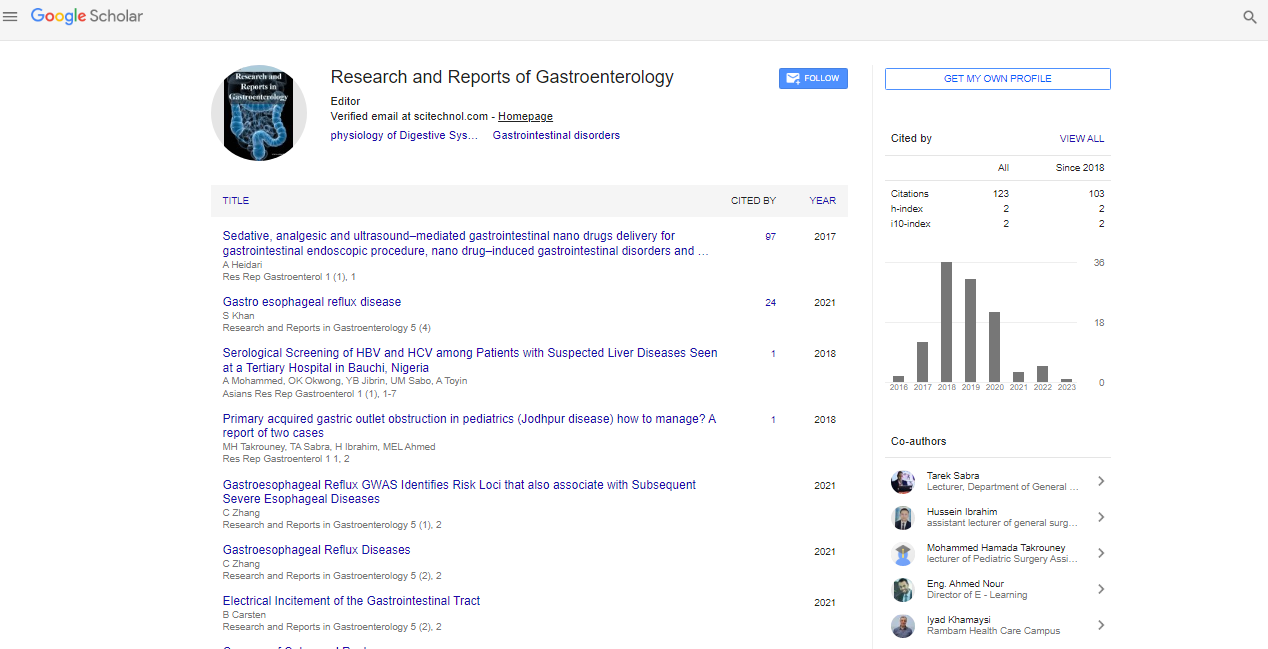Perspective, Res Rep Gastroenterol Vol: 7 Issue: 4
Malabsorption Syndromes: Understanding the Challenges of Nutrient Absorption
Jonathan Hursitoglu*
1Department of Pediatrics, University of Virginia, Charlottesville, USA
*Corresponding Author: Jonathan Hursitoglu,
Department of Pediatrics,
University of Virginia, Charlottesville, USA
E-mail: hursitoglujonathan@gmail.com
Received date: 20 November, 2023 Manuscript No. RRG-24-124030;
Editor assigned date: 22 November, 2023, PreQC No. RRG-24-124030 (PQ);
Reviewed date: 06 December, 2023, QC No. RRG-24-124030;
Revised date: 13 December, 2023, Manuscript No. RRG-24-124030 (R);
Published date: 20 December, 2023, DOI: 10.4172/Rrg.1000155
Citation: Hursitoglu J (2023) Malabsorption Syndromes: Understanding the Challenges of Nutrient Absorption. Res Rep Gastroenterol 7:4.
Description
Malabsorption syndromes represent a group of disorders characterized by the impaired absorption of nutrients from the gastrointestinal tract. This complex array of conditions poses significant challenges to those affected, impacting the absorption of vital nutrients such as fats, proteins, carbohydrates, vitamins, and minerals.
Understanding malabsorption syndromes
Malabsorption syndromes can result from various underlying causes, including structural abnormalities, inflammation, infections, and genetic factors. Common conditions contributing to malabsorption include celiac disease, Inflammatory Bowel Disease (IBD), chronic pancreatitis, and Small Intestinal Bacterial Overgrowth (SIBO). In each case, the normal absorption process is disrupted, leading to deficiencies in essential nutrients.
The symptoms of malabsorption syndromes are diverse and often overlap with other gastrointestinal disorders. Chronic diarrhea, weight loss, abdominal pain, bloating, and fatigue are common manifestations. Deficiencies in specific nutrients may give rise to additional symptoms, such as anemia, osteoporosis, neurological abnormalities, and skin disorders.
Types of malabsorption syndromes
Celiac disease is an autoimmune disorder triggered by the ingestion of gluten, a protein found in wheat, barley, and rye. In individuals with celiac disease, the immune response to gluten damages the lining of the small intestine, impairing nutrient absorption. A strict gluten-free diet is the primary treatment for celiac disease.
Inflammatory Bowel Disease (IBD) including Crohn's disease and ulcerative colitis, involves chronic inflammation of the digestive tract. Inflammation disrupts the absorptive surface of the intestine, leading to malabsorption of nutrients. Treatment aims to manage inflammation and may include medications and, in severe cases, surgical interventions.
The pancreas plays a crucial role in digestion by producing enzymes necessary for nutrient absorption. In chronic pancreatitis, inflammation and scarring of the pancreas impair enzyme production, affecting the digestion of fats and proteins. Enzyme supplements are often prescribed to alleviate malabsorption in these cases.
Small Intestinal Bacterial Overgrowth (SIBO) occurs when there is an abnormal overgrowth of bacteria in the small intestine. These bacteria can interfere with nutrient absorption and cause inflammation. Antibiotics and dietary changes are common strategies to manage SIBO and address malabsorption.
Diagnostic approaches
Blood tests can identify deficiencies in specific nutrients, such as iron, vitamin B12, and folate. Elevated levels of certain antibodies may also indicate conditions like celiac disease.
Stool tests help assess fat absorption by measuring the levels of fat in the stool. Increased fat content can indicate malabsorption.
Endoscopic procedures, such as upper endoscopy or colonoscopy, allow direct visualization of the gastrointestinal tract. Biopsy samples can be obtained to assess the health of the intestinal lining and identify any abnormalities.
Imaging techniques, such as CT scans or MRIs, may be used to identify structural abnormalities, inflammation, or other conditions affecting nutrient absorption.
Treatment and management
Tailoring the diet to the specific needs of the individual is a cornerstone of managing malabsorption syndromes. For example, those with celiac disease must strictly avoid gluten, while individuals with lactose intolerance may benefit from limiting dairy products.
Depending on the nutrient deficiencies identified, supplementation may be prescribed. This could include vitamin and mineral supplements or enzyme replacements for individuals with pancreatic insufficiency. In cases of inflammatory conditions like IBD, medications to reduce inflammation may be prescribed. Immunomodulators and biologics are among the options to manage chronic inflammation. For conditions like SIBO, antibiotic therapy is often employed to reduce bacterial overgrowth and restore a healthier balance in the gut.
Malabsorption syndromes present a multifaceted challenge to both patients and healthcare providers. The diverse array of underlying causes necessitates a thorough diagnostic approach, often involving a combination of clinical, laboratory, and imaging assessments. Treatment strategies are varied and tailored to the specific condition, emphasizing dietary modifications, supplementation, and, in some cases, targeted medications. As research and medical understanding continue to evolve, the hope is to refine diagnostic tools and therapeutic approaches, ultimately improving the quality of life for individuals grappling with malabsorption syndromes.
 Spanish
Spanish  Chinese
Chinese  Russian
Russian  German
German  French
French  Japanese
Japanese  Portuguese
Portuguese  Hindi
Hindi 